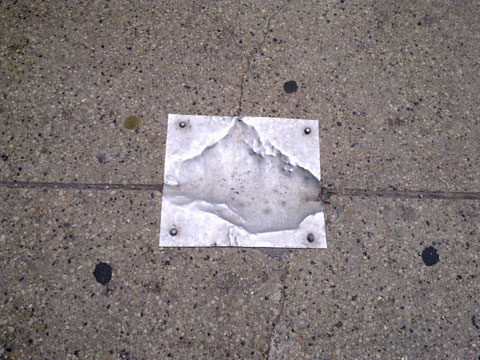Plan And Budget For Web Site Repairs
Every time I walk by this it cracks me up, so much that I had to take a picture of it and talk about it here, and how it related to the Web. Below is a photo of part of a sidewalk in Chicago near the northeast corner of Madison and Canal Streets. And what you think you may see is correct, a piece of metal bolted over a hole in the sidewalk.

As peculiar as it appears, unfortunately it is not an anomaly. There are many sidewalks in the Windy City which are patched with metal or plywood. This is most likely the result of the fact that many sidewalks are vaulted (or hollow underneath) which is a throwback to the days when the only way you could get goods into a building were through a lift in the sidewalk to the basement. As the logistics – and cost – to repair a vaulted sidewalk are high, many times something is just bolted over the hole to cover it.
Ideally, the owner of a building with a vaulted sidewalk should be aware of their condition and appropriately budget for its repair or replacement, just as they should be anticipating other repairs in the building. The same holds true for the owners of Web sites.
Web Sites Need Repairs Too
There are 2 cases when a Web site needs to be repaired, with one being driven by the business and the other by technology.
From a business standpoint, a Web site should be closely synchronized with the entity it represents. This includes everything from an accurate phone number to an extension of services offered by the entity to the Web site. If the content of your Web site frequently changes and the site doesn’t have a content management system (CMS) then you should consider adding one, thereby reducing the cost of manually maintaining content. If you send statements or other documents to your customers, making these available on your Web site could reduce labor and mailing costs to get these out. As social media tools become more robust, integrating them into your Web site will give you an advantage to reach out to your fans and followers, who hopefully will become customers.
Technical repairs to a Web site can greatly vary. Whenever a new version of a Web browser is released, your Web site should be tested against it. In some cases, some code on your Web site, such as JavaScript, may not work in a new version. The Web site itself didn’t change, the browser did. As Apple is not allowing Flash to be displayed on the iPhone and iPad, if you have it on your Web site, it will not display on these 2 devices. As smartphones become more and more common, your Web site may require a mobile version to best display on these smaller-screened devices.
Be Prepared
Just as with a home or car repair, Web site repairs will need your time to be addressed, will need to be scheduled and will cost money. Where you cannot always anticipate when repairs will be needed (just as you can’t predict when your refrigerator will stop working) it is best to set aside some funds for your Web site’s eventual repair. How much you will need to save will depend on the size and complexity of your Web site, and your Web consultant can help you with this decision-making. As well, they can help you with identifying potential problem areas and recommend a schedule for you as well. If they cannot, feel free to contact Dunkirk Systems, LLC, as we are more than glad to talk to you about how to best manage your Web site.
Did you enjoy reading this? You are welcome to subscribe to The Hot Iron by RSS feed or by email.
Comments
Post a Comment
Note: Comment moderation is active, and your comment will be viewable once it is reviewed.

